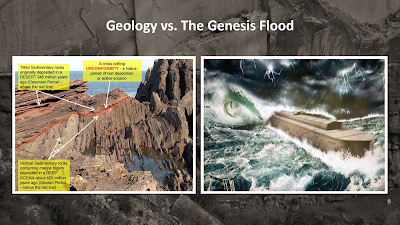One such line of evidence pertains to the formation of shale, which accounts for about 70% of the sedimentary rock found in the earth's crust. Together with limestone and sandstone, shale deposits contain nearly all of the fossils found on earth. Some shale deposits are thousands of meters thick.
Shale is made in watery environments as silt and clay settle out to form thin, delicate layers, called laminae (plural of lamination), which can be less than 1mm thick. These layers build up over time and form rock as they are compacted and dried out.Until recently, it was thought that laminae can only form in nearly still waters, since microscopic clay particles would be swept up by moving water, preventing them from settling. Geologists have maintained that the entire process is very gradual, requiring tens of millions of years to lay down thick shale deposits.
But recent laboratory research, using a large simulation tank called a flume (top), has shown that laminae do, indeed, form in moving water under optimal conditions, and at a faster rate than was once thought possible. This groundbreaking research is being conducted by Juergen Schieber at Indiana University.
Dr. Schieber's discovery has been promoted by young earth, creation scientists in videos and articles as breakthrough evidence for the flood theory. They believe that the massive shale deposits which were once thought to require millions of years to form in still waters, were laid down by fast moving waters in the last few months of Noah's flood, as the waters receded.
On the surface this may sound plausible, but the devil is in the details, which creation scientists typically gloss over. After reviewing some of the literature surrounding Dr. Schieber's research, I reached out to him by email with some additional questions, which he was kind enough to answer.
The flume experiments show that sediment accumulation is based on the speed of the current. At high speeds (>25 cm/sec), most clay particles remain suspended instead of falling to the bottom to form laminae. The optimal speed of deposition is 20-25 cm/second, which is about 1/2 mph. This is 1/100th to 1/80th of the velocity calculated by creation scientists for Noah's flood, except, perhaps, at the very end of the process, after nearly all of the water has receded.
At optimal speed, sediment accumulates at the rate of only 1-2 cm per week. That amounts to about 0.5 to 1 meter per year. The water content of the freshly deposited sediment is around 85%. In order to form shale, the water needs to be squeezed out by compaction. That will reduce our 1 meter layer of sediment to 15 cm of rock. Under optimal conditions, then, the rate of shale formation will not exceed 15 cm per year. Needless to say, this is infinitely slower than the flood scenario imagined by creation scientists.
We can gain an appreciation for scale by considering the Belt Basin formation of Montana and Idaho, which is approximately 20 km thick. Though not all of it is shale (some is sandstone and limestone), it still illustrates the point. At 15 cm per year, it would take over 133,000 yrs to form 20 km of rock. This assumes that ideal conditions of speed and sediment load are maintained over the entire stretch of time—a virtual impossibility in the real world. Taking into consideration the intermittent nature of flow and deposition, a more realistic number might be 5x to 10x longer.Given these limitations, it is clear that recent research in sedimentology provides no on-ramp for flood geology. Unfortunately, creation scientists have a reputation for selectively citing research in support of their cause, while ignoring the inconvenient facts that contradict their beliefs. The universal flood theory fails for many other reasons, both scientific and Biblical, some of which I present in my video, Science & Christianity: 2. Geology vs. The Genesis Flood.
Yet, the Biblical Flood has not been entirely dismissed by geologists. Many regard it as a regional event. David R. Montgomery discusses this view in his book, The Rocks Don't Lie: A Geologist Investigates Noah's Flood. A group of 11 Christian scientists, writing from a similar perspective, published a fully illustrated volume on the Flood, The Grand Canyon: Monument to an Ancient Earth. Noah’s Flood is even mentioned as a regional flood in the



